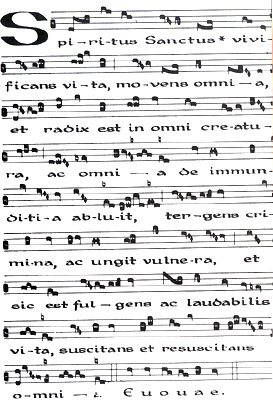About
Plainsong and Gregorian Chant
| Plainsong is a term that describes a
style of singing of the church liturgy on the European continent that was developed early
in the first millennium. Plainsong is monophonic, meaning that it has a melody only, and no
accompanying chords or instruments. The principal types of plainsong in the western part
of the European continent consist of the Gallican, Gregorian,
Ambrosian, Old Roman, and
Mozarabic styles. In the eastern part they are the Syrian, Armenian, and Byzantine. |
 |
Our introduction to plainsong will be
confined to the Gregorian style, also known as Gregorian Chant; however, we encourage
exploration into the other styles because there is a great wealth of beauty to be
discovered in the other styles of music.
Gregorian chant is the
liturgical music
that was sung in the Roman Catholic Church from the fifth or sixth centuries until the
Second Vatican Council of 1962 - 1965 when it was removed from the church! Gregorian chant
was named for St. Gregory the Great who was pope from 690 to 604. Beginning late in the
11th Century, Gregorian chant began to be joined in church services by a newer style of
music called polyphony. Polyphony used more that a single melody simultaneously (mono =
one, poly = many). During the renaissance period, polyphony developed into a great body of
music. Polyphonic music was largely based on the melodies of Gregorian chant and
compositions in the polyphonic style often replaced the original Gregorian compositions in
services, while retaining the same words (as these were a part of the
liturgy). After the
15th Century, church services often consisted of a mixture of polyphonic and monophonic
music. Psalms, hymns, and magnificats were set in such a way that verses alternated
between plainsong and polyphony.
The importance, spiritual power and
beauty of the great body of Gregorian chant cannot be over emphasized.
|
"By superceding the Latin language of the Mass
and substituting 19th Century hymns of questionable
aesthetic value for Gregorian and polyphonic music, the
[Catholic] Church itself forces us to turn to the museum
of recordings if we want to hear this priceless,
peerless, and beautiful branch of musical art."
Egon
F. Kenton
From the liner notes of Turnabout Recording TV 34309
A visitor to the
website informs us concerning the above quote:
"You indicate that chant was removed from Catholic
liturgy after Vatican II. This is not correct. Vatican
II instructed that certain parts of the liturgy may be
changed, e.g., certain prayers may be said in the vernacular
and music other than chant may be used. All designed to
increase the understanding of the laity's role in
liturgy. Any changes on a local level could only be done
with permission of the bishop. As with anything, once an
exception is made, the exception becomes the rule. Now
very few Catholic churches use chant or latin; and most
people believe that chant and latin are no longer part
of Catholic liturgy. But again, this is not accurate and
will probably take 100 years to correct itself."
|
|

